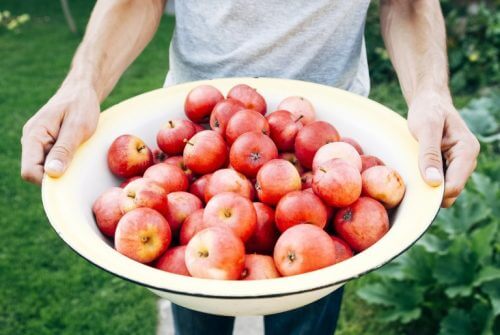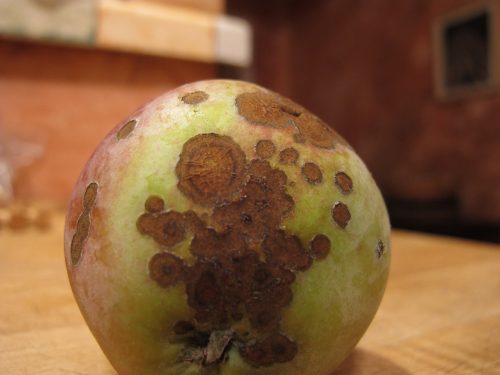Farmers and researchers across the country are making efforts to bring red, healthy and nutritious apples to the holiday table, and are fighting a disease that can destroy 85 percent of the apple crop

The holiday season has arrived, and Rosh Hashanah is at its head - the holiday where we tremble to the sound of shofar blowing and celebrate the flavors of apples in honey. In most homes, the apple dipped in honey will be red and juicy, with a bright color and crunchy content.
Many apple varieties are sold in Israel. The main and well-known red varieties are Gala, Straking, Jonathan and Ona. The Pink Lady apples, which have acclimatized wonderfully with us after coming to Israel from Australia, are picked about two months after Rosh Hashanah - so it is likely that Straking and Jonathan apples, which are usually picked close to the holiday, will star on your holiday table. These are beautiful apples that grow in the Golan Heights and the Galilee and whose color easily competes with Snow White's apple. However, unlike the apple from the children's play, the apples we eat are neither poisonous nor poisonous. On the contrary, apples are full of vitamins and dietary fiber as well as sugars and fluids. But in order for them to reach the holiday table, the farmers and researchers fight a multitude of fungi, bacteria and insects, which attack the apple fruit and cause its pink cheeks to turn pale with terror, and after a successful attack also to turn black and rot.
This is the story of the sock disease, which threatened the local apple crop and the upcoming Rosh Hashanah celebrations.
The apple attackers
Do you know the heartache we experience when we bite into the beautiful red fruit and discover that the center is rotten? This is a common example of a fungus that damages apples, and its name is Alternaria alternata. The fungus is responsible for the decay of the seed house (the inside of the apple) in Streking apples. The spores of the fungus penetrate the flower during flowering and establish themselves in the fruit even before it is formed. Many fruits are thrown into the trash in this way, although there is no objection to eating the healthy apple and throwing only the rotten part in the trash.
Another fungus, a relative called Alternaria mali, attacks cracks in Pink Lady apples and causes the underside of the fruit, known as pit, to rot while still on the tree. Without spraying, up to 70 percent of the entire Pink Lady crop may be infected with such external rot, causing enormous damage to farmers, and at the same time to the consumer. However, through a combination of spraying and growing under a net, Lior Gor from the Shamir Research Institute succeeded significantly reduce the damage to the fruit and almost completely prevented the development of rot.
The apple has no socks

Another disease that desperately affects the red apple fruits is the sock disease (sock), which is caused by a fungus called venturia inaequalis. Prof. Moshe Reuvani from the Shamir Research Institute, the head of the team investigating the fungus, explains that it is one of the most studied fungi in the world - therefore its life cycle, the optimal conditions for infection and the development of the fungus are known to researchers almost perfectly.
But this is about the only thing that is perfect about this mushroom, from an agricultural and consumer point of view. The reason so much is known about this fungus is its heavy damage. The apple sock disease is one of the most serious diseases of the sensitive apple varieties, and it is considered one of the apple diseases with the economic damage the highest in the world. In addition to early shedding of infected leaves, the disease causes the fruit to be deformed, so the infected fruit cannot be sold. Infected fruits are theoretically edible, but in a second stage cracks are formed in the infected area, and through these cracks additional fungi penetrate which cause the fruit to rot and fall prematurely.
The initial infection occurs in the spring, when the tree's buds begin to open. The infection process itself is quite interesting: the sexual spores of the fungus that survived the winter in the tissue of the fall leaves of the previous season ripen, and with the spring rains they are released from the leaf tissue and infect the young green tissue. This is how the first infection is done. The fungus then establishes itself and causes gray spots on the fruit, where asexual spores are also formed, and they are the ones that help the fungus spread itself throughout the orchard.
Without scheduled sprayings with effective fungicides, in difficult years you can also see 85 percent damage to the crop and its destruction. In Israel, this disease is widespread in the north of the Golan Heights and the Galilee in the Red Delicious and Pink Lady varieties, and in the Emek Hula region and other areas in the Ona and Odem varieties.
Genetics of resistance
To prevent the infection of the trees with the apple sock, preventive spraying is carried out before the rains, the purpose of which is to prevent the fungus from germinating and penetrating into the tissue of the leaf or the apple fruit. There are various preparations to prevent infection with the apple sock disease that work in different ways, depending on the active ingredient in them. Among the common preparations, in the preparation based on strobilurins the breathing process of the fungus is prevented, and in the preparations based on triazoles the production of the fungal cell wall is damaged.
So far everything is fine and dandy, and it seems that there is a way to fight the fungus that causes the disease. But as you can see In the video This one, which shows how quickly bacteria develop resistance to antibiotics, fungi can also develop resistance to pesticides. How does that happen? The fungi that are not resistant are controlled with high efficiency. But after a certain period of time, a spore or mycelium (the webs that make up the body of the fungus) will become less sensitive to the product, and from it will grow a fungus with reduced sensitivity or even resistance, which will spread its spores and create a population of fungi resistant to the pesticide. Over time, some of these fungi will contain the trait of resistance to the substance in a genetic form, passing it on to future generations.
Many times, the population in question will grow to the point where spraying with the same pesticide will be like spraying with water, and will require taking new measures to prevent the disease - such as, for example, the development of new preparations based on a different active substance, at the same time as stopping the use of an ineffective substance until the natural balance of The resistant population and the population that is not resistant.
In recent decades, many cases of the resistance of the fungus have been documented in the world venturia inaequalis - the one that causes the sock disease - to fungicides. The first documentation was found in the fifties of the last century in New York, the second in the seventies, and in 1997 resistance to fungicides from the strobilurin group was documented in Switzerland. Since then resistance has been found in many areas around the world. This resistance is caused by a single mutation in one gene.
In recent years, the farmers and researchers in Israel have observed a decrease in the effectiveness of the pest control treatments with preparations from the strobilurin group in the apple orchards in Israel, which created a fruitful collaboration between researchers from the Shamir Institute for Research led by Prof. Moshe Reuvani and the team of Dr. Omar Frankel From the Volcanic Institute, where we will examine whether resistance to the fungus actually exists in apple orchards in Israel venturia inaequalis , causing the sock disease in apple.
In the first step, the researchers observed plots of apple trees of the Straking variety and tested the effectiveness of different pesticides from the strobilurin family compared to other products known to be effective, and to an untreated control group - trees that were not sprayed. The observations confirmed the researchers' fears, and they indeed observed a reduction in the effectiveness of these preparations in the apple orchards.
At the same time, the researchers collected samples of leaves and fruits infected with the fungus from several plots, isolated the fungi in the laboratory and grew them on a substrate of artificial food. Afterwards, pieces of these mushrooms were placed on a substrate of food poisoned with various pesticides, to test the effectiveness of the preparations. Efficacy was tested by measuring the diameter of mushroom growth. The researchers found that, except for a single case, no difference was found between the diameter of the mushrooms treated with strobilurin-based preparations compared to the untreated control group. This experiment also confirms the researchers' concerns, and indicates that the fungus did develop resistance to the preparation based on strobilurins - while the other preparation maintained its effectiveness.
To check whether the fungus is also genetically resistant, DNA was extracted from the collected samples and compared to the Internet database of NCBI, a database whose purpose is to make information about DNA sequences accessible to the public while collaborating with various researchers and laboratories. In all but one of the samples, the genetic mutation was found, which indicates the resistance of the fungus to the preparation. The results of the study are presented In the September issue of the newspaper Alon Hnotate.
until next year
The holiday meal is just around the corner, and you've probably noticed that the apple stands in the grocery store are full of reddish and healthy goods. The reason for this is that the farmers did not need the results of the research to act: the decrease in the effectiveness of the common family of preparations caused so much damage that it can be seen with the naked eye. The farmers realized that the resistant fungus was spreading in their orchards, so they started spraying the apples with other fungicides.
In addition to this threat, farmers are faced with another variety of diseases, fungi and other pests, and that's before we even talked about the ravages of the weather. Without spraying, proper watering, pruning and shaping the tree and thinning the fruit, the harvest would have been much poorer, and it is doubtful that there would have been enough beautiful, reddish apples for the holiday table.
